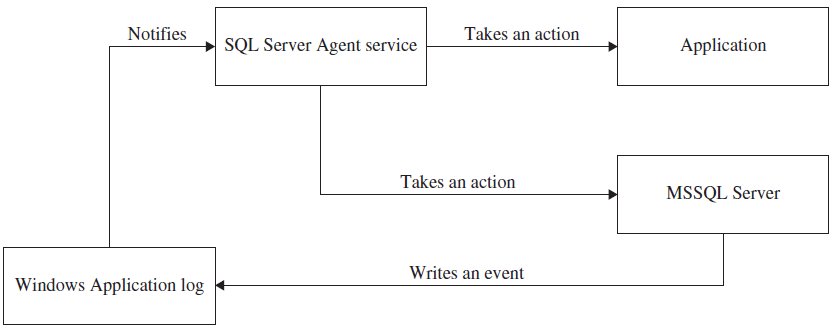Automating System Administration Tasks
One of the most important advantages of the Database Engine in relation to other relational DBMSs is its capability to automate administrative tasks and hence to reduce costs. The following are examples of some important tasks that are performed frequently and therefore could be automated:
- Backing up the database and transaction log
- Transferring data
- Dropping and re-creating indices
- Checking data integrity
You can automate all these tasks so that they occur on a regular schedule. For example, you can set the database backup task to occur every Friday at 8:00 p.m. and the transaction log backup task to occur daily at 10:00 p.m.
The components of the Database Engine that are used in automation processes include the following:
- SQL Server service (MSSQLSERVER)
- Windows Application log
- SQL Server Agent service
Why does the Database Engine need these three components to automate processes? In relation to automation of administration tasks, the MSSQLSERVER service is needed to write events to the Windows Application log. Some events are written automatically, and some must be raised by the system administrator (see the detailed explanation later in this chapter).
The Windows Application log is where all application and system messages of Windows operating systems and messages of their components are written. The role of the Windows Application log in the automation process is to notify SQL Server Agent about existing events.
SQL Server Agent is another service that connects to the Windows Application log and the MSSQLSERVER service. The role of SQL Server Agent in the automation process is to take an action after a notification through the Windows Application log. The action can be performed in connection with the MSSQLSERVER service or some other application. Figure 17-1 shows how these three components work together.

Starting SQL Server Agent
SQL Server Agent executes jobs and fires alerts. As you will see in the upcoming sections, jobs and alerts are defined separately and can be executed independently. Nevertheless, jobs and alerts may also be complementary processes, because a job can invoke an alert and vice versa.
Consider an example: A job is executed to inform the system administrator about an unexpected filling of the transaction log that exceeds a tolerable limit. When this event occurs, the associated alert is invoked and, as a reaction, the system administrator may be notified by e-mail or pager.
Another critical event is a failure in backing up the transaction log. When this happens, the associated alert may invoke a job that truncates the transaction log. This reaction will be appropriate if the reason for the backup failure is an overflow (filling up) of the transaction log. In other cases (for example, the target device for the backup copy is full), such a truncation will have no effect. This example shows the close connection that may exist between events that have similar symptoms.
SQL Server Agent allows you to automate different administrative tasks. Before you can do this, the process has to be started. To start SQL Server Agent, right-click SQL Server Agent and choose Start.
As already stated, the invocation of an alert can also include the notification of one or more operators by e-mail using Database Mail. Database Mail is an enterprise solution for sending e-mail messages from the Database Engine. Using Database Mail, your applications can send e-mail messages to users. The messages may contain query results, and may also include files from any resource on your network.
